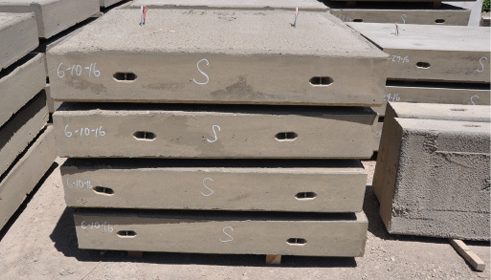Concrete Concepts forms a natural mask for petrochemical complex
|
|
| Construction of the site walls along the west bank of the Ohio River proceeded in mid-2016. CCI delivered the final panel load earlier this year. PLANT, SITE PHOTOS: Concrete Products |
 |
A precast operator under fourth- and fifth-generation management is on the ground floor of one of western Pennsylvania’s largest construction undertakings since World War II. Reaching beyond its signature drainage and utility structures, plus Reinforced Earth-licensed products, Concrete Concepts Inc. (CCI) of McKees Rocks, Pa., secured a contract covering 2,065 lagging panels for site walls along the Ohio River. The west bank structures front the southern edge of a 400-acre, Beaver County, Pa., brownfield to be reclaimed over the next five years as a Shell Chemical Appalachia, LLC, petrochemical complex with ethane cracker.
Two walls running in staggered 4- to 40-ft. heights and more than 2,000 ft. in length follow natural and new plant contours. Specifications underscore Shell Chemical’s aesthetic, environmental and concrete performance objectives: CCI cast the 9-in. thick panels with integrally colored mixes, ensuring the finished wall harmonizes with its surroundings. That aspect is especially apparent from Vanport Township, directly across the river along the east bank, or approaching the site in the Interstate 376 bridge westbound lanes.
Reinforced with epoxy-coated rebar, the panels range from 2- x 5-ft. to 4- x 8-ft.; those deeper than 2 feet have false joints to project a uniform 2-ft. joint across a 47,000-sq.-ft. face. Standard and sloping top panels are uniformly 8-ft. and 5-ft. wide and vary in height. Panels are either solid or bear small diameter weep holes or larger square block outs for wall drainage and/or tieback connections. The precast schedule included 31 standard and 250-plus unique panel sizes.
“It took a lot of coordinated effort between our engineering staff and the contractor to create the panel arrangement that incorporated the different features of the wall, from the multiple rows of tiebacks, to the even 2-ft. joint spacing, to the sloping top contour of the wall, resulting in the amount of panel types we had,” says CCI President David Bryan.
A spring and summer 2016 casting window saw peak production days net 500 square feet of product. CCI developed a self-consolidating mix with Sika ViscoCrete polycarboxylate high range water reducers, eyeing a 28-in. spread. The producer tapped Shale Green pigment from the new Chromix Admixtures Naturescapes series. L.M. Scofield, which was acquired by the Swiss parent of Sika Corp. just as panel production began, launched Naturescapes in 2015 to complement the U.S. Bureau of Land Management’s Standard Environmental Colors guide. The premium pigments enable concrete surfaces to blend with target applications by reflecting the darker, more recessive color schemes of native soils or vegetation. “We ran multiple tests prior to casting, to ensure the integral coloring was compatible with the SCC mix we developed, and confirm that our forming materials created a smooth, clean finish on the concrete produced,” affirms Bryan.
 |
| The panel mix design bears Naturescapes Shale Green pigment at approximately 80 lbs./yd.; ViscoCrete HRWR impart self-consolidating properties. Concrete Concepts crews realized better consistency using a 10-yd. transit mixer truck, repurposed from a sister Bryan Materials Group ready mixed site, versus a 2-yd. plant mixer. |
 |
| The seven-month Shell panel fabrication window has been followed by expansion of the CCI McKees Rocks plant—located just outside Pittsburgh—that will approximately double floor space, with new area earmarked for wet cast box culvert production and other specialty structures. The expansion is scheduled for mid-2017 completion. |
PRECAST PRELIMINARIES
Concrete Concepts is the precast arm of Bryan Materials Group (BMG), a western Pennsylvania construction fixture since 1883. In addition to CCI, BMG spans Pittsburgh ready mixed businesses Frank Bryan Inc. and Quality Concrete, plus four aggregate production or distribution operations along a 50-mile Ohio River stretch from Pittsburgh to the Ohio border. Georgetown Sand and Gravel, a BMG company since 1996, and a recently added ready mixed operation, Beaver Concrete & Supply, are the Bryan operations closest to the Shell Chemical Appalachia site. Both are positioned to supplement concrete construction activities at the petrochemical complex site in the coming years.
Pittsburgh’s Trumbull Corp. awarded CCI the panel contract. The river bank walls, along with a new 500-car precast/prestressed parking structure from Ohio’s R.W. Sidley, are the main above-grade structures project observers will see through next year’s main construction phase start. Present efforts center on extensive earth moving and foundations to accommodate the ethane cracker’s massive equipment and infrastructure networks, and seal contaminated soil from the site’s legacy owner, a zinc-smelting predecessor of today’s Horsehead Holding Corp.
 |
| Presented here from the west, the complex will require a construction payroll up to 6,000 through 2020-21, and a projected 600 permanent employees when completed. The Potter Township, Pa., site lies on the west bank of the Ohio River, adjacent to Interstate 376 and about 30 miles northwest of Pittsburgh. Concern for the complex’s visual impact from the east bank is evident. Shell Chemical Appalachia invested in color-fast, long life cycle site walls, rising here in summer 2016 from a Vanport Township vantage. |
 |
After a five-year gauge of market conditions and project feasibility, coupled with state and local economic development incentives, Shell Chemical Appalachia confirmed the multi-billion dollar Beaver County master plan in June 2016. The cracker will use low-cost ethane from Marcellus and Utica basin shale gas to process more than 1.75 million tons of polyethylene annually for products ranging from food packaging and containers to automotive components. Compared to the Texas and Louisiana Gulf Coast—ground zero for North American petrochemical production—Shell Chemical Appalachia and customers will benefit from close proximity to gas feedstock, and a shorter, more dependable supply chain. More than 70 percent of North American polyethylene customers are within a 700-mile radius of Pittsburgh. RENDERING: Shell Chemical Appalachia, LLC
